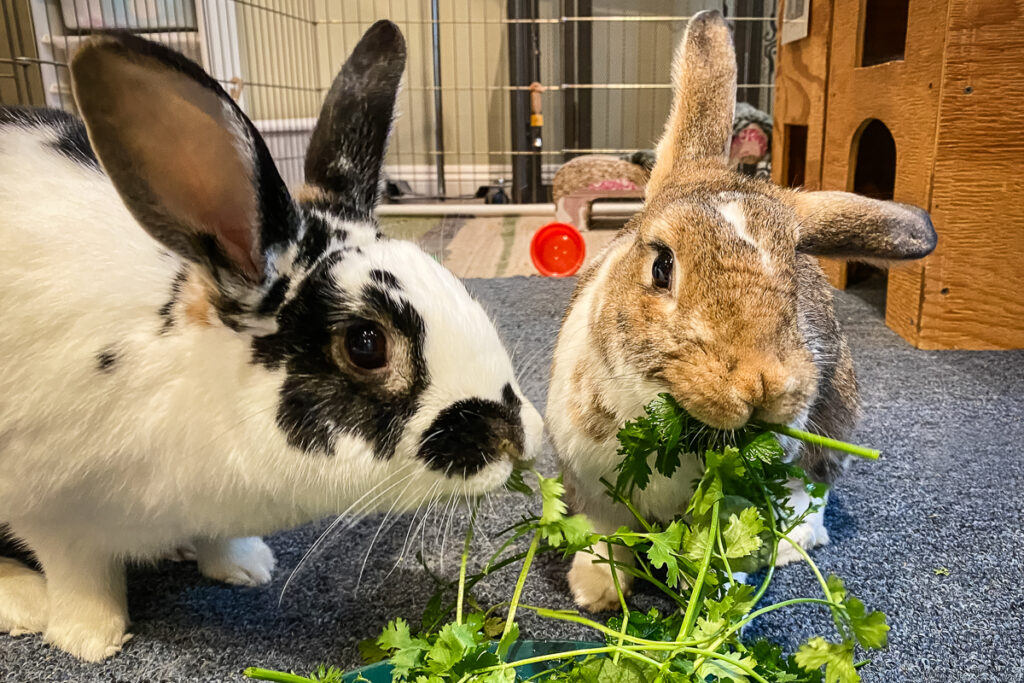in consultation with Cindy McBee, DVM
Animal Fat and the Protein Myth
Humans are now learning that we require much less protein than previously believed. Even strict vegetarians may consume more protein than necessary. Rabbits possess neither the need for animal protein nor the capacity to process it, and their fat requirement is also low; 1-2% is plenty for most.
Studies have shown that rabbits, like humans, develop atherosclerosis-like symptoms when exposed to the cholesterol in animal fat (Cheeke 1987, 325; Beynan 1990, 185-186). Experts in rabbit nutrition have said that “it is well recognized that vegetable oils usually are more digestible and have a higher energy value for swine and poultry than do animal fats. This appears to be true in rabbits also” (Cheeke 1987, 99). Why, then, do we sometimes see animal fat and animal fat derivatives on the ingredients list of rabbit pellets?
Since pellets are manufactured and marketed primarily for breeders, and since most breeder rabbits are subject to more stress than house rabbits, many brands of pellets are labeled as “performance” feeds. These brands contain a high level of protein (16-22%), which is probably necessary to keep alive a rabbit who lives in an environment without climate control, is bred as often as possible, or is nursing most of the time. Physical, environmental, and psychological stresses require high energy levels for survival.
A healthier protein percentage for spayed or neutered house rabbits is approximately 12-14%, a level at which it is possible to find pellet brands that contain no animal fat and list at least some actual ingredients on their labels. People who buy small amounts of “rebagged” pellets in bulk at pet supply stores should be sure to ask to see the bag the food came in and read the label carefully. Purchasing a 25# bag and splitting it with a friend may be safer and more economical. Unfortunately, one well-known manufacturer recently increased the protein in their maintenance diet to 16%. Although the food still contains no animal fat, this is more protein than a house rabbit needs.
Not the Best for All Rabbits
Having said all this, it may still come as a surprise that in recent years many veterinarians and house rabbit caretakers have come to the conclusion that commercial pellets, particularly when fed in large amounts, may not be the best choice for all rabbits. After all, pellets were developed for breeders as a concentrated source of nutrients. They contain all the vitamins and minerals a rabbit requires in a palatable form that keeps for many weeks, is easy to feed, and is (compared to dog or cat food) extremely inexpensive.
The highly concentrated nature of pellets ensures that rabbits gain weight quickly, important for many breeders since those rabbits not bred are often slaughtered for meat by the age of 16 weeks. (UFAW Handbook 1987, 426).
Clearly, when “production” is the goal there is considerable pressure for weight gain and maintenance, and very little concern with geriatric matters. Needless to say, no house rabbit lives under these conditions. Most are spayed or neutered, live indoors with minimal environmental stress, and can expect to make it to six to twelve years of age. In these rabbits, the concentrated nature of pellets can lead to obesity and its attendant medical problems.
A Better Way
Because of several potential problems associated with pellets, some veterinarians now recommend that pellets be not only rationed, but rationed quite severely. Instead of giving the rabbit all she can eat in a day, a night, or a few hours, we have been considering the following amounts as maximums (Brown 1994):
- 5-7 lb of body wt. 1/4 cup daily
- 8-10 lb body wt. 1/2 cup daily
- 11-15 lb of body wt. 3/4 cup daily
There is evidence that small breeds (under 2 lbs) may require a diet higher in energy and lower in fiber than the larger breeds (Cheeke 1987, 324). Several foster homes have experienced digestive problems in rabbits under 4 lbs who were put on severely restricted diets.
Once pellets have been reduced, it is equally important to make sure that fresh grass hay is available to the rabbit at all times, and that fresh vegetables be given in larger amounts than has previously been recommended (up to 2-4 cups a day). Actually, because of the problems usually associated with the overfeeding of pellets, some rabbits do better if they receive no pellets at all. Instead, they eat several cups of fresh veggies a day and all the grass hay they want. Other rabbits still eat pellets, but receive significantly less than the above amounts, with a corresponding increase in the amount of vegetables offered. These more extreme measures are particularly helpful for overweight rabbits who need to lose weight safely. Treats should be limited to small (1 tsp.) amounts of fresh fruit. Most starches should be avoided, since too much carbohydrate has been associated with enteritis. Oats and barley in small amounts can be digested by rabbits but can, nonetheless, provide more calories than necessary.
In feeding trials in which pelleted feed was reduced to 50% of normal intake and the diet was supplemented with greens, young rabbits maintained normal growth. When the amount of pellets was reduced to below 50% of “normal,” growth rate declined (Pote et al 1980). These studies indicate that even young, unaltered rabbits do well on a reduced pellet diet. Since most of our house rabbits need to lose weight rather than gain, reducing pellets below 50% should not affect spayed or neutered adults adversely.
What Kinds of Vegetables?
There are different opinions regarding which vegetables are the best for rabbits. Nearly everyone agrees that, carrot tops, broccoli, and parsley are safe, and that beansa and potatoes are potentially problematic. Rescuer have used many veggies with success, including collard, mustard, dandelion and turnip greens, spinach, kale (please use sparingly), endive and Romaine lettuce.
It is best to feed at least 3 types of greens daily, because feeding one type only can lead to nutrient imbalances (Brown 1994). However, such imbalances are less likely to occur if at least a small amount of pellets is given each day.
Mustard greens, spinach and perhaps kale, contain high levels of oxalates, the salts of oxalic acid, which can accumulate in the system and cause toxicity over time. Rather than eliminating these veggies from your list (because they are highly nutritious and loved by most rabbits), limit your use of them to 1-3 meals a week. One method is to feed kale (with other veggies) for several days until 1-2 bunches are gone, then avoid buying it again for a week or so. The same precautions can be taken with the veggies that are high in calcium if your rabbit is prone to urinary tract stones. Particularly for rabbits who eat no or few pellets, try to include at least one veggie daily that is high in vitamin A (such as carrots, collard or mustard greens, endive, or parsley). If all these instructions seem complicated, simplify things by making sure you vary your rabbit’s diet as much as possible to avoid giving too much or too little of any one food. This makes good sense for all of us!
The most important aspect of increasing the amount of vegetables in a rabbit’s diet (and the amounts mentioned here represent a radical increase for most rabbits) is to do so gradually. Even if a particular vegetable is safe for your rabbit, giving her a cupful when she is unaccustomed to such riches could wreak havoc on her digestive tract. Instead, begin with something that has been previously successful, such as carrot. Increase the amount slightly, and as long as no diarrhea occurs, add a small portion of a new veggie every few days. This way, you can be sure which food is the culprit if digestive problems are experienced.
The best fresh foods for rabbits are those that have been grown organically, without the use of pesticides; in any case, be sure to wash your rabbit’s vegetables thoroughly. Rather than scraping carrots (which removes the nutritious skin), scrub them with a vegetable brush. The key is to remove any dirt or pesticide residue, and to check carefully for rotted areas. Unless you are sure wild dandelions are protected from pesticides, check at your local health food store for organically grown ones.
Catching Problems Early
One potential side effect of this more natural diet, is that it is easier to notice when your rabbit has a decrease in appetite. This may help you to notice some illnesses more quickly. If a rabbit fed in this way backs off her food even slightly, there is probably something wrong (early enteritis, for instance) which can now be treated several days earlier than it would otherwise. Most rabbit caretakers welcome this peace of mind, and most veterinarians are thrilled to see a rabbit before the problem becomes an emergency.
Continuing Research
Even if you greatly increase the amount of vegetables your rabbit receives, we are reluctant at this time to recommend eliminating pellets from a rabbit’s diet entirely unless there is a pressing medical reason to do so. Just as grain has its place in the diet of a horse, pellets have their place in the diet of a rabbit, and giving a small amount every day ensures that the diet remains balanced. Still, our experiences in HRS, and those of veterinarians who see a large number of rabbits, do indicate that the amount of pellets given to most house rabbits is far too high for their nutritional needs. As time goes by and we hear more about the results of diet variations, we will certainly learn even more about using nutrition to keep our rabbits healthy and happy for as long as possible, so let us know about your experiences. As always, we learn more from the rabbits we know than from any other source.
Works Cited
Beynen, A.C. and M. Sugano. 1990. “Dietary protein as a regulator of lipid metabolism: State of the art and new perspectives.” Journal of Nutritional Science and Vitaminology 36, Suppl. 2: S185-8.
Brown, Susan. 1994. Care of Rabbits. Working handout for clients. Midwest Bird and Exotic Animal Hospital, Westchester, Il.
Cheeke, Peter R. 1987. Rabbit Feeding and Nutrition. Orlando: Academic Press.
Jenkins, Jeffrey R. 1993. A Practitioner’s Guide to Rabbits and Ferrets. Lakewood, CO: American Animal Hospital Association.
Pote, L.M., Cheeke, P.R., and Patton, N.M. 1980. “Use of greens as a supplement to a pelleted diet for growing rabbits.” Journal of Applied Rabbit Research 3, 15-20.
The UFAW Handbook on the Care and Management of Laboratory Animals. 1987. 6th edition. Ed. Trevor B. Poole. Essex: Longman Scientific and Technical.
©Copyright Elizabeth TeSelle. All Rights Reserved. Republished with the permission of the author.
Natural Nutrition Part II: Pellets and Veggies was originally published in House Rabbit Journal Volume III, Number 4.

